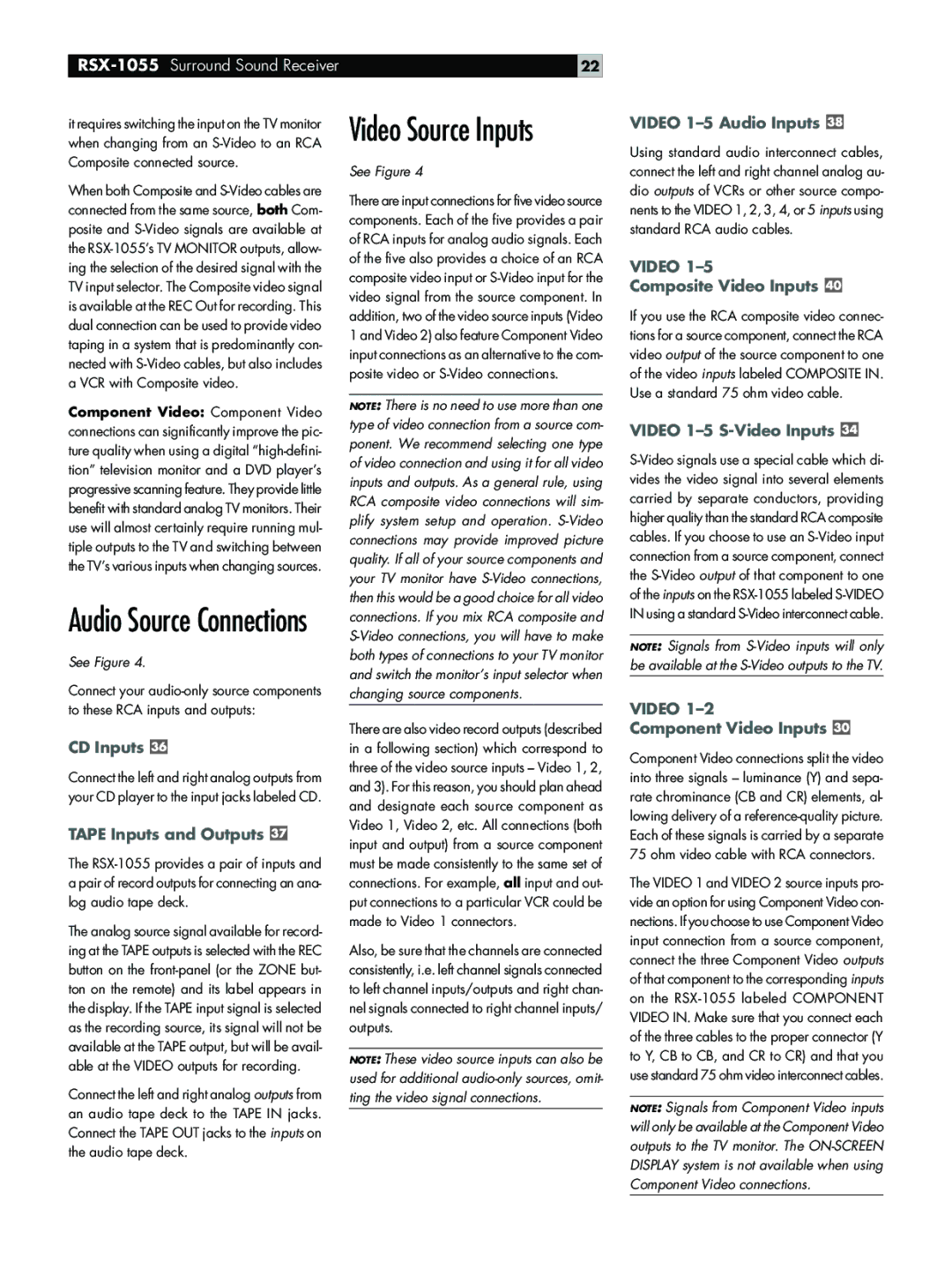it requires switching the input on the TV monitor when changing from an S-Video to an RCA Composite connected source.
When both Composite and S-Video cables are connected from the same source, both Com- posite and S-Video signals are available at the RSX-1055’s TV MONITOR outputs, allow- ing the selection of the desired signal with the TV input selector. The Composite video signal is available at the REC Out for recording. This dual connection can be used to provide video taping in a system that is predominantly con- nected with S-Video cables, but also includes a VCR with Composite video.
Component Video: Component Video connections can significantly improve the pic- ture quality when using a digital “high-defini- tion” television monitor and a DVD player’s progressive scanning feature. They provide little benefit with standard analog TV monitors. Their use will almost certainly require running mul- tiple outputs to the TV and switching between the TV’s various inputs when changing sources.
Audio Source Connections
See Figure 4.
Connect your audio-only source components to these RCA inputs and outputs:
CD Inputs 
Connect the left and right analog outputs from your CD player to the input jacks labeled CD.
TAPE Inputs and Outputs 
The RSX-1055 provides a pair of inputs and a pair of record outputs for connecting an ana- log audio tape deck.
The analog source signal available for record- ing at the TAPE outputs is selected with the REC button on the front-panel (or the ZONE but- ton on the remote) and its label appears in the display. If the TAPE input signal is selected as the recording source, its signal will not be available at the TAPE output, but will be avail- able at the VIDEO outputs for recording.
Connect the left and right analog outputs from an audio tape deck to the TAPE IN jacks. Connect the TAPE OUT jacks to the inputs on the audio tape deck.
Video Source Inputs
See Figure 4
There are input connections for five video source components. Each of the five provides a pair of RCA inputs for analog audio signals. Each of the five also provides a choice of an RCA composite video input or S-Video input for the video signal from the source component. In addition, two of the video source inputs (Video 1 and Video 2) also feature Component Video input connections as an alternative to the com- posite video or S-Video connections.
NOTE: There is no need to use more than one type of video connection from a source com- ponent. We recommend selecting one type of video connection and using it for all video inputs and outputs. As a general rule, using RCA composite video connections will sim- plify system setup and operation. S-Video connections may provide improved picture quality. If all of your source components and your TV monitor have S-Video connections, then this would be a good choice for all video connections. If you mix RCA composite and S-Video connections, you will have to make both types of connections to your TV monitor and switch the monitor’s input selector when changing source components.
There are also video record outputs (described in a following section) which correspond to three of the video source inputs – Video 1, 2, and 3). For this reason, you should plan ahead and designate each source component as Video 1, Video 2, etc. All connections (both input and output) from a source component must be made consistently to the same set of connections. For example, all input and out- put connections to a particular VCR could be made to Video 1 connectors.
Also, be sure that the channels are connected consistently, i.e. left channel signals connected to left channel inputs/outputs and right chan- nel signals connected to right channel inputs/ outputs.
NOTE: These video source inputs can also be used for additional audio-only sources, omit- ting the video signal connections.
VIDEO 1–5 Audio Inputs 
Using standard audio interconnect cables, connect the left and right channel analog au- dio outputs of VCRs or other source compo- nents to the VIDEO 1, 2, 3, 4, or 5 inputs using standard RCA audio cables.
VIDEO 1–5
Composite Video Inputs 
If you use the RCA composite video connec- tions for a source component, connect the RCA video output of the source component to one of the video inputs labeled COMPOSITE IN. Use a standard 75 ohm video cable.
VIDEO 1–5 S-Video Inputs 
S-Video signals use a special cable which di- vides the video signal into several elements carried by separate conductors, providing higher quality than the standard RCA composite cables. If you choose to use an S-Video input connection from a source component, connect the S-Video output of that component to one of the inputs on the RSX-1055 labeled S-VIDEO IN using a standard S-Video interconnect cable.
NOTE: Signals from S-Video inputs will only be available at the S-Video outputs to the TV.
VIDEO 1–2
Component Video Inputs 
Component Video connections split the video into three signals – luminance (Y) and sepa- rate chrominance (CB and CR) elements, al- lowing delivery of a reference-quality picture. Each of these signals is carried by a separate 75 ohm video cable with RCA connectors.
The VIDEO 1 and VIDEO 2 source inputs pro- vide an option for using Component Video con- nections. If you choose to use Component Video input connection from a source component, connect the three Component Video outputs of that component to the corresponding inputs on the RSX-1055 labeled COMPONENT VIDEO IN. Make sure that you connect each of the three cables to the proper connector (Y to Y, CB to CB, and CR to CR) and that you use standard 75 ohm video interconnect cables.
NOTE: Signals from Component Video inputs will only be available at the Component Video outputs to the TV monitor. The ON-SCREEN DISPLAY system is not available when using Component Video connections.

